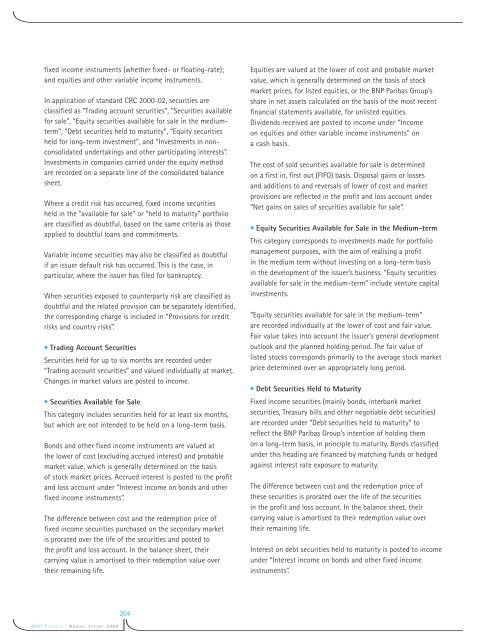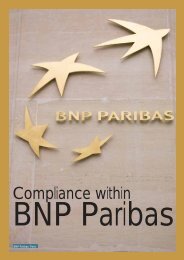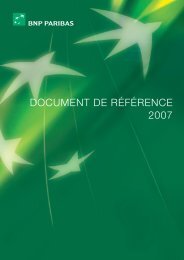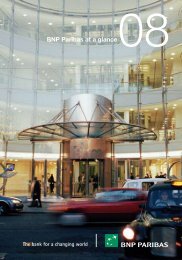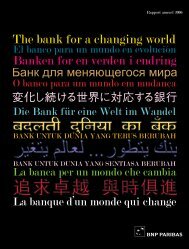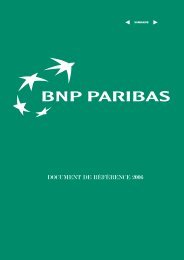La banque d'un monde qui change 2004 - BNP Paribas
La banque d'un monde qui change 2004 - BNP Paribas
La banque d'un monde qui change 2004 - BNP Paribas
You also want an ePaper? Increase the reach of your titles
YUMPU automatically turns print PDFs into web optimized ePapers that Google loves.
fixed income instruments (whether fixed- or floating-rate);and e<strong>qui</strong>ties and other variable income instruments.In application of standard CRC 2000-02, securities areclassified as “Trading account securities”, “Securities availablefor sale”, “E<strong>qui</strong>ty securities available for sale in the mediumterm”,“Debt securities held to maturity”, “E<strong>qui</strong>ty securitiesheld for long-term investment”, and “Investments in nonconsolidatedundertakings and other participating interests”.Investments in companies carried under the e<strong>qui</strong>ty methodare recorded on a separate line of the consolidated balancesheet.Where a credit risk has occurred, fixed income securitiesheld in the ”available for sale” or ”held to maturity” portfolioare classified as doubtful, based on the same criteria as thoseapplied to doubtful loans and commitments.Variable income securities may also be classified as doubtfulif an issuer default risk has occurred. This is the case, inparticular, where the issuer has filed for bankruptcy.When securities exposed to counterparty risk are classified asdoubtful and the related provision can be separately identified,the corresponding charge is included in “Provisions for creditrisks and country risks”.• Trading Account SecuritiesSecurities held for up to six months are recorded under“Trading account securities” and valued individually at market.Changes in market values are posted to income.• Securities Available for SaleThis category includes securities held for at least six months,but which are not intended to be held on a long-term basis.Bonds and other fixed income instruments are valued atthe lower of cost (excluding accrued interest) and probablemarket value, which is generally determined on the basisof stock market prices. Accrued interest is posted to the profitand loss account under “Interest income on bonds and otherfixed income instruments”.The difference between cost and the redemption price offixed income securities purchased on the secondary marketis prorated over the life of the securities and posted tothe profit and loss account. In the balance sheet, theircarrying value is amortised to their redemption value overtheir remaining life.E<strong>qui</strong>ties are valued at the lower of cost and probable marketvalue, which is generally determined on the basis of stockmarket prices, for listed e<strong>qui</strong>ties, or the <strong>BNP</strong> <strong>Paribas</strong> Group’sshare in net assets calculated on the basis of the most recentfinancial statements available, for unlisted e<strong>qui</strong>ties.Dividends received are posted to income under “Incomeon e<strong>qui</strong>ties and other variable income instruments” ona cash basis.The cost of sold securities available for sale is determinedon a first in, first out (FIFO) basis. Disposal gains or lossesand additions to and reversals of lower of cost and marketprovisions are reflected in the profit and loss account under“Net gains on sales of securities available for sale”.• E<strong>qui</strong>ty Securities Available for Sale in the Medium-termThis category corresponds to investments made for portfoliomanagement purposes, with the aim of realising a profitin the medium term without investing on a long-term basisin the development of the issuer’s business. “E<strong>qui</strong>ty securitiesavailable for sale in the medium-term” include venture capitalinvestments.“E<strong>qui</strong>ty securities available for sale in the medium-term”are recorded individually at the lower of cost and fair value.Fair value takes into account the issuer’s general developmentoutlook and the planned holding period. The fair value oflisted stocks corresponds primarily to the average stock marketprice determined over an appropriately long period.• Debt Securities Held to MaturityFixed income securities (mainly bonds, interbank marketsecurities, Treasury bills and other negotiable debt securities)are recorded under “Debt securities held to maturity” toreflect the <strong>BNP</strong> <strong>Paribas</strong> Group’s intention of holding themon a long-term basis, in principle to maturity. Bonds classifiedunder this heading are financed by matching funds or hedgedagainst interest rate exposure to maturity.The difference between cost and the redemption price ofthese securities is prorated over the life of the securitiesin the profit and loss account. In the balance sheet, theircarrying value is amortised to their redemption value overtheir remaining life.Interest on debt securities held to maturity is posted to incomeunder “Interest income on bonds and other fixed incomeinstruments”.204<strong>BNP</strong> PARIBAS - ANNUAL REPORT <strong>2004</strong>


